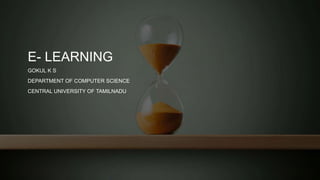
Elearning week5
- 1. E- LEARNING GOKUL K S DEPARTMENT OF COMPUTER SCIENCE CENTRAL UNIVERSITY OF TAMILNADU
- 2. SCENARIO BASED LEARNING What is a scenario? In e-learning, it is the description of a task or job situation from the learner’s perspective. A sequence of concrete problems are described, and choices are presented that enabled the learner to reach a satisfactory outcome. As a result, it focuses on performance improvement rather than correct answers, supplies information only as needed, and boosts engagement by using images and sound.
- 3. SCENARIO BASED LEARNING CONT… SBL asks the learner to apply knowledge relevant to that situation by making choices and attempting to follow a desirable path that demonstrates their ability to achieve a successful outcome. Instead of right and wrong answers there are sucsess and failure paths.
- 4. SCENARIO BASED LEARNING CONT… Distinguishing Features of SBL The key difference between traditional e-learning and SBL is the way in which content and learning activities are devised. Traditional courseware emerges from subject-matter experts and the established knowledge base of a subject. Learning objectives and activities are ‘deduced’ from this body of facts. SBL’s derive their objectives and activities out of real experiences and the real work situations. Meetings with experienced people are held to identify objectivies and activities.
- 5. SCENARIO BASED LEARNING CONT… SBL screen design example
- 6. SCENARIO BASED LEARNING CONT… Aim to negoiate a successful path through the learning program. Navigation Strategy 1. Choose from success and fail options at start. 2. If success option then proceed to next options. 3. If ‘moderate’ fail option then receive remediation and proceed to next options. 4. If ‘diaster’ fail option then receive feed back and return to start. 5. Repeat for successive sets of options until complete.
- 7. PROBLEM BASED LEARNING (PBL) Problem based learning is a process of acquiring and understanding of knowledge, skills in the context of an unfamiliar situation and applying that learning to the situation. “Problem based learning is the basic human learning process that allowed primitive man to survive in his environment”- Barrows and Tamblyn (1980). “Problem based learning is student centred learning strategy in which students collaboratively solve the problems and this reflects on their experience. In PBL, the starting point is a problem, a query, or a puzzle that the learner wishes to solve”- D.L Bound, 1985
- 8. GOALS OF PROBLEM BASED LEARNING Construct an extensive & flexible knowledge base. Develop effective problem – solving skills. Develop self-direction, lifelong learning skills. Becomes effective collaborators. Strengthen student’s intrinsic motivation to learn.
- 9. PRINCIPLES The student is the focus of the educational program, the curriculum or the curriculum contents. The problem presented in the curriculum trigger the student’s abilities to analyze to understand and to solve. Co-operation with other and the importance of communication is emphasized. The development of self-directed learning ability.
- 10. COMPONENTS Non-lecture format & teacher acting as a facilitator. Presentation of real world situation or problem from ordinary life. Group work and group discussion. Student-directed solution of the selected problem.
- 11. THE PBL CYCLE Experiential learning Experience Apply Share Generalize Process The PBL cycle starts with applying (planning effective use of learning). The second step is experiencingn(activity phase). The third step involves sharing (exchanging reactions and observations). The fourth step includes processing (discussing patterns and dynamics.) The fifth step relates to generalizing ( development and real world priciples).
- 12. STUDENTS ROLE Students have to assume a high degree of responsibility for their our education through effective self learning working with others and setting relevant goals for themselves & the group as a whole. Students be able to present demonstrations of their learning achivements.
- 13. ADVANTAGES It stimulates the students to use skills of inquiry and critical thinking, peer teaching and peer evaluation. It increases student responsibility for self directed peer learning. This learning method helps in developing lifelong learning skills. It encourages students to work in teams or groups, there by facilitating group dynamics. Increased motivation for learning is the added advantage.
- 14. DISADVANTAGES Students require orientation to perform the role of a learner in PBL setting. Resource expensive. Staff and students may be initially uncomfortable with PBL because they are used to subject based learning and they do not really understand how to proceed in PBL. Measurement of learning outcomes is difficult.
- 15. TOP DOWN AND BOTTOM UP MODELS IN CURRICULUM DEVELOPMENT Top Down Design Model In top-down model, an overview of the system is formulated, without going into detail for any part of it. Each part of the system is then refined in more details. Each new part may then be refined again, defining it in yet more details until the entire specification is detailed enough to validate the model.
- 16. TOP DOWN CONCEPT IN PROBLEM SOLVING If we look at a problem as a whole, it may seem impossible to solve because it is so complex. - writing a University System program Complex problems can be solved using top-down design, also known as stepwise refinement, where - we break the problem into parts - then break the parts into parts - soon, each of the parts will be easy to do
- 17. TOP DOWN DESIGN Main Task Sub task 1 Sub task 2 Sub task 3
- 18. ADVANTAGES OF TOP-DOWN DESIGN Breaking the problem into parts helps us to clarify what needs to be done. At each step of refinement, the new parts become less complicated and, therefore, easier to figure out. Parts of the solution may turn out to be resuable. Breaking the problem into parts allows more than one person to work on the solution.
- 19. BOTTOM-UP DESIGN In bottom-up design individual parts of the system are specified in details. The parts are then linked together to form larger components, which are in turn linked until a complete system is formed.
- 20. BOTTOM - UP DESIGN